Historic Train Wrecks of Bartow County
A look at rail tragedies in the Empire County between the 1840’s and 2022
By: Joe F. Head
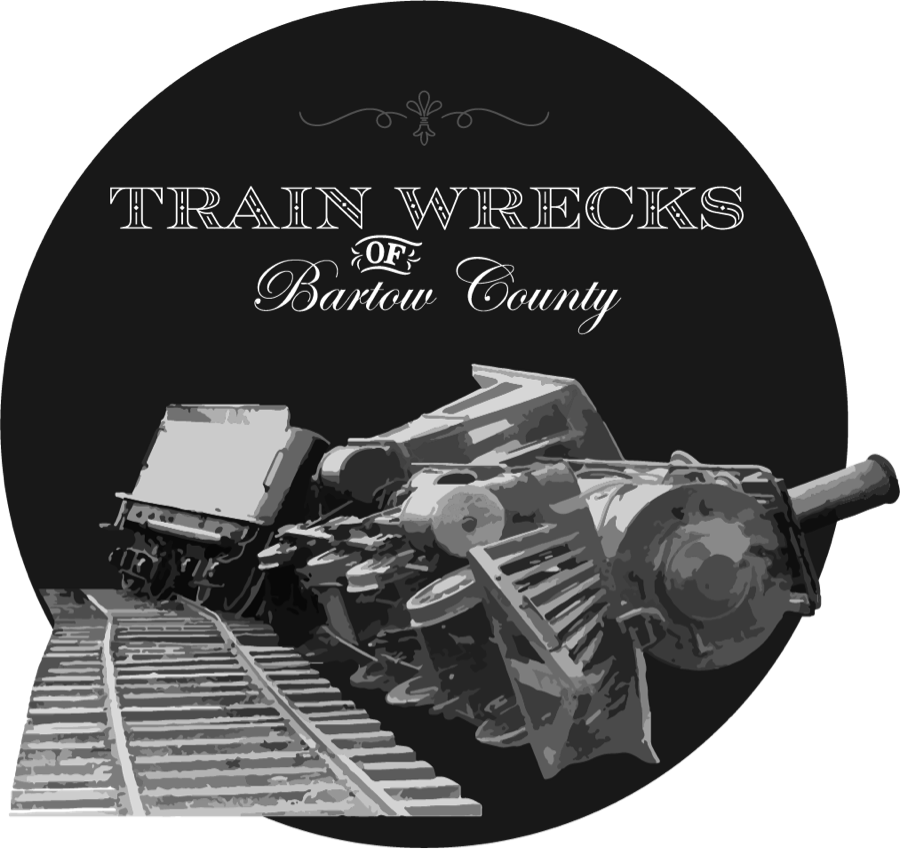
Among the primary influences that established early Bartow County one must agree that rail history has played a major role in the development of what has been called the Empire County of north Georgia. As a result of the many railroads that have operated in the county, so too does a story emerge of twisted and mangled train wrecks combined with human tragedies.
The early occupation of Bartow County and its heritage may rest on four historic features that established its rise and initial success as a frontier settlement in the early 1830’s. First, the historic Etowah River Valley was inhabited by Native Americans who left significant remains of their past as evidenced by mounds, fish weirs, rock structures, burials and the Trail of Tears saga. Secondly, prospectors soon arrived to mine gold and in the process found a bonanza of abundant ores embedded in the red hills of early Cass County. This industry led to a dozen stone furnaces built to smelt pig iron and the need to transport product to market. Thirdly, Bartow was soon on track to be a part of the ambitious Western and Atlantic state railroad project to build a road connecting Atlanta and Chattanooga. And finally, the importance of the railroad through Bartow County during the Civil War adds further credence to the impact of Bartow rail history.
Bartow (formerly Cass County) was officially founded in 1832 following the nation’s first gold rush in north Georgia. Soon the county became involved in the great westward expansion to connect the heart of America to the Atlantic Ocean by building the Georgia owned Western and Atlantic Railroad (W&ARR). This project was a cooperative between Tennessee and Georgia to build a rail based commerce route east from the Mississippi River at Memphis to Chattanooga. The road would then run south to Atlanta and then east to Augusta connecting with the Savannah River and the Atlantic Ocean reaching European markets. The objective was to reduce shipping time down the Mississippi and avoid navigating the Gulf of Mexico around Florida and then to the Atlantic. The short cut to lay track between Memphis and Atlanta would also offer many added advantages to interior towns and expedite shipping time.
As the great Western and Atlantic Railroad (W&ARR) project unfolded, Cass County attracted keen mining interest from entrepreneurs seeking to piggy-back on the W&A RR and ship ores and freight from the county to distant markets. As a result, home grown railroads eventually emerged in Bartow that connected to the W&ARR between, 1837 to 1900. Following the Civil War the state owned W&A rail bed was leased to other railroad companies to include: Nashville Chattanooga & St. Louis (NC & St.L), Louisville & Nashville (L&N), CSX and other lines that rented rights to run trains on the rails.
Following the construction of the W&A RR, five indigenous railroad beds evolved in Bartow County including: Cooper’s Etowah RR, Rome RR at Kingston, Iron Belt RR between Rogers and Sugar Hill, Tennessee Iron and Coal in Bartow/Emerson and the Cartersville Van Wert (AKA Cherokee Iron Co RR & East – West RR) between Cartersville and Rockmart. Additionally, two rail beds were built by L&N and CSX specifically to service their corporate needs. In 1906, L&N opened a line between Cartersville and Etowah, Tennessee and is referred to as the Etowah – Cartersville New Line. In 1906 NC&StL (L&N) constructed a short line by-pass (coal loop) northwest of Cartersville. Today, among other commerce this line services fuel needs of Georgia Power’s Plant Bowen in Euharlee. This line tied into the former Cartersville – Van Wert rail bed.
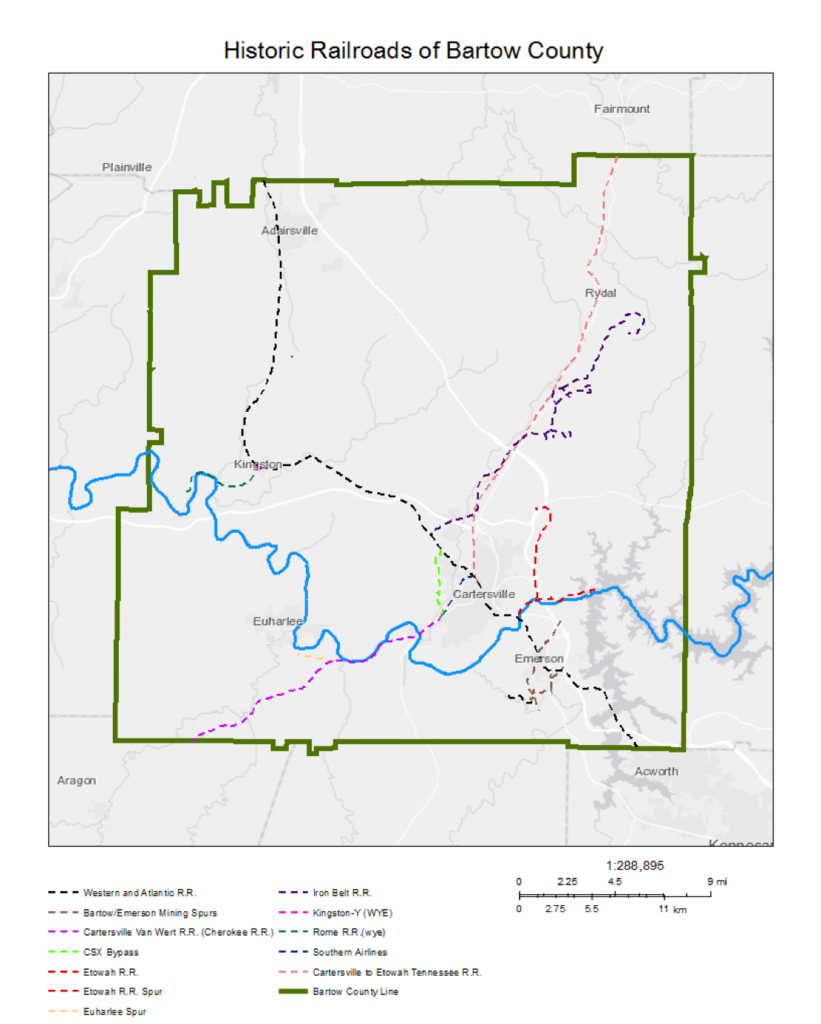
Research uncovered a plethora of small-scale accidents involving trains colliding with automobiles, wagons, minor derailments, operational mishaps and people being hit along the tracks by moving trains. Many small accidents occurred on all the railroads in Bartow County and were far too vast in number to mention each in this study. This topic clearly revealed a preponderance of calamities from Cartersville south through Emerson, Bartow, Allatoona to the Hugo water stop at the county line. The number of small wrecks and deaths related to rail mishaps along this stretch was ghastly in frequency and suffering and too many to list. However, token citations are included and a few of these instances will be fully represented at the close of this work, but the core of this research will be dedicated to the major wrecks and catastrophes found in Bartow County. Most descriptions are drawn from newspaper articles and have been paraphrased for quick reading.
Train Wrecks, Tragedies and Entanglements
As grim as it sounds, there is something captivating about shipwrecks and train wrecks. People yearn to hear of stories that surround each incident and keep alive the tales of disasters in order to remember heroism or memory of loved ones. Both type of wrecks seem to enjoy folklore in the form of song and romantic legends than do other transportation disasters. As a result, Bartow shares in this mystique of legendary wrecks as a part of local railroading history.
The Valley of the Shadow of Death
Early operations on the W&A RR between Atlanta and Chattanooga were less than stellar during its first century and earned the road an undesirable reputation. Newspapers reported frequent smash ups, run offs, collisions, turn overs, loss of life and maimed or mutilated bodies as a result of riding the rails. It was soon learned that riding the W&ARR could be at one’s on risk. This unfortunate era spanned from the1840’s through the 1950’s before significant improvements were implemented. In fact, letters of protest from passengers printed in regional newspapers claimed bad management and careless operations by state authorities. Disasters became so bad and so frequent that tabloids commonly reported disparaging headlines or introductions of yet another negligent tragedy. The pride of Georgia’s State Road had become known as the Valley of the Shadow of Death, as reported in January 15, 1852 by Augusta’s Daily Chronicle. The press chastised the state legislature for procrastinating and not taking responsibility for poor management referring to its supervisors as imbeciles and incompetent managers.
It was not uncommon for defective equipment to cause loss of life and damage to property. The Augusta Daily Chronicle reported a fatal explosion of the W&A engine, Delaware near McGuire’s Curve at the Etowah Station. One trainman was killed and several injured. The cause was reported to be “bad iron” used in the construction of the engine boiler. Other wrecks of the this period also included flash fires that were sparked by wood burning stoves used in the passenger cars during cold weather.
The Great Chase: The earliest records of Bartow train wrecks appear prior to the Civil War and forward. Perhaps the most famous episode regarding trains in Bartow County would point to the Great Locomotive Chase. While not an official train wreck, the event itself christens the topic as it is considered to be the greatest railroad adventure in American history. The event led to a chase and recovery of a hijacked W&A RR locomotive, The General. Union raiders hijacked the locomotive from Big Shanty in Kennesaw with the intentions of burning bridges along the W&A RR north through Bartow County to Chattanooga, destroy tracks and telegraph lines along the way. Considering the action, distance covered and that all chase engines were acquired in Bartow the heart of the chase did indeed occur in Bartow County. Had the mission been successful, Bartow would have faced a devastating railroad set back far exceeding a traditional train wreck.
McGuire’s Curve: Oral history and state documents speak of a treacherous section of track known as McGuire’s Curve that was built by the State during the original 1841 W&A RR construction. This section existed south of the Civil War period Etowah River bridge. The curve accounted for scores of derailments and accidents suffered by the W&A RR and NC & St L RR. As a result, in 1944, with the anticipated Corp of Engineer’s Allatoona Dam project several miles of track were relocated west toward highway 293. This alteration eliminated the dangerous curve and pulled approximately six miles of original track bed between Cartersville and Emerson away from the impacted dam construction project area to the west.
In the infancy of the W&A, Kingston became a major junction due to the addition of the Rome railroad made possible by the WYE allowing a rail connection between the state road and Rome, Georgia. As a result of this junction many mishaps and massive accidents occurred in the community. Additionally, just a few miles north was a lime kiln industry owned by the Rev. C. H. Wallace that also was the site of many derailments and nuisances to the W&A. Rev. Wallace fell in dispute with the state railroad superintendent in 1855 regarding turn out sidetracks used to load his limestone. Wallace maintained that accidents had not been that serious and to force a relocation of sidings would be costly and put contract labor out of work for a period of time waiting for his product to be delivered. The argument reached the papers for public awareness, but ultimately the state ignored Wallace’s case of imaginary damages to his business and instructed for the sidings to be moved and reinstalled satisfactory to the state.

Providential and Singular Escape, 1846
The earliest record of a train accident found in this research happened just north of the county seat on the State Road. On February 10, 1846 the Brooklyn Evening Star, Louisville Daily Courier and Baltimore Sun reported a bridge collapse over the Oothcalaga Creek north of Cassville (near Adairsville) on the W&A RR. The Engine with five freight cars and 25 passengers all fell into the stream below. There were no fatalities, nor injuries. According to the Cassville Pioneer news printed on January 23 the locomotive namesake was ironically named for the Oothcalaga Creek. The engine had only been in service for several months before the accident. The freight was hauling iron ore with crew aboard. The collapse was estimated to be approximately six feet to the water and caused little damage. A schedule of Georgia locomotives printed in the 1847 Merchant’s Magazine cited the cost of repairs to be $432.00 or $3,100.00 in 2019 dollars.
Letter to the public, 1852. One of the earliest records of a train wreck begins with a letter printed by the Charleston Courier in January 1852. A passenger wrote an open letter to the public about a train wreck on Tuesday January 13 that he was involved in approximately mid way between Cartersville and Cass Station on the W&A RR. The southbound passenger from Chattanooga was behind schedule and met an up bound passenger train without incident. After consultation it was agreed the south bound would back onto a Cass Station siding to allow the north bound to pass. However, an unanticipated southbound freight under full steam was encountered and an inevitable jarring collision resulted. The crew from the southbound freight jumped to safety, but the passengers in the returning train were severely injured. The letter describes how powerful the impact was crushing all passenger cars. Most passengers suffered broken legs, ankles, cuts and many will be crippled for life. He placed the responsibility of the accident clearly on bad management of the State of Georgia.
The Chiefton and Senator, 1863: Perhaps Bartow’s first documented train disaster during the Civil War occurred in Emerson, Georgia between the Chiefton and Senator locomotives. In September 1863 the southbound Chiefton collided head on with the northbound Senator in the deep cut about one mile north of Emerson adjacent to state highway 293. The southbound train may have been empty or carrying wounded Confederate soldiers while the northbound train was transporting fresh troops from Tennessee regiments to the northern battlefields. Both locomotives were running at high speed at night without lights and upon collision the engines fell on their sides with the cars and men scattered all along the rail bed. Casualties reported were confused as a result of men already wounded and dead on the southbound train. Best accounts attribute between 12 and 18 bodies were recovered for burial following the wreck. Records and oral history credit these deaths to having established the Confederate Cemetery in Marietta as the bodies were all eventually transferred there for interment.
Cartersville Van Wert Adventure, Circa 1870’s
According to an excerpt in the book, In the Light of Other Days, written by Caroline Couper Lovell of Etowah Cliffs near Euharlee an accident occurred on the Van Wert Railroad. She speaks of her cousins witnessing a train on the Cartersville Van Wert line crossing the Etowah River bridge, but before the train made if fully across the bridge collapsed. The train was a mix of freight and passenger cars and only one car length longer than the bridge. All but the passenger and baggage car plunged into the river. As fate would have it the witnesses had taken the train into Cartersville that morning, but decided to drive back to Malbone that afternoon. Amazingly, all the crew and passengers survived. When the crew and passengers gathered on the bank her cousin knelt with them and led everyone in prayer.
Rogers Station 1870’s
A number of wrecks occurred between1873 and 1900 at Rogers Station north of Cartersville. The 73 wreck was the result of a freight train derailing and a following passenger train colliding with the rear of the freight. No injuries and little damage was reported. Similar accidents occurred at Rogers Station as a result of misplaced switches and signal mishaps.
Van Wert Engine Run Off, 1876
The Cartersville Express reported that on February 17, the Nickajack locomotive of the Cartersville-Van Wert RR ran off the tracks about one mile west of the city. The engine sustained severe damage when it ditched along with two cars it was pulling. No injuries were reported.
Fall of a Railroad Bridge, 1878
A number of newspapers reported on a bridge collapse over the Etowah River west of Cartersville on the Cherokee (Van Wert) railroad. The engine and six cars stretched across the river forming a perfect dam. No fatalities, but several were injured according to various papers. The cause of the collapse was simply assigned to the bridge being too rotten. (It is possible this incident may be that described in the book, In the Light of Other Days, mentioned above.)
Ride to Death, 1882:
The Atlanta Constitution reported on June 20, 1882 a massive midnight collision involving none other than the Great Locomotive, The General. This event involving the General has largely escaped public or historic attention about the famed locomotive. The accident occurred in the rail community of Kingston when two track switches were left open that threw the southbound General into the rear of a side tracked train. The engineer, Andrew J. West died shortly after the impact and the fireman, George Bass was severely injured, but survived. The story reports that the General was at maximum speed of 35 to 40 miles an hour and was not scheduled to stop in Kingston. Once the sudden switch occurred the General plowed through several sidetracked cars. The General was also pulling coach cars, but passengers suffered no serious injuries. However, as the wreck was sorted out an injured hobo was discovered in one of the smashed boxcars. He could not account for what happened and was completely disoriented to where he was and his identity. Later it was determined he was John Fitzpatrick from Philadelphia.
In a subsequent article printed by the Cartersville Free Press, January 4, 1883 it was learned that criminal negligence was suspected in the catastrophe. The railroad hired a private detective who relentlessly researched the case. It was discovered that a black man had sued and lost a case over an injury regarding a crushed hand on a previous railroad incident. He had sworn to get revenge after the case. He was tied to five previous derailments and found to possess a set of switch keys.
Georgia Car Company Explodes, 1882
Little known today is the once thriving railroad car manufacturing industry that once stood in the center of town. Following the Civil War two railroad car manufacturers erected plants adjacent to the W&A RR tracks. Each were producing as many as 20 to 25 cars per week and hired between 100 and 200 hands. The first (Cartersville Car Manufacturer) was located where the Grand Theater stands today and the other (Georgia Car Company) about two blocks south approximately behind the current day Tribune News. On February 17, 1882 the Georgia Car Company suffered a devastating boiler explosion that killed six men and severely injured several others. This event was so massive it destroyed, equipment and buildings, but the paper reported the business rebounded to fill its order for 800 railroad cars.
A Narrow Escape, 1886
On the East West Railroad a passenger cab unexpectedly detached and the engine was reversed to catch the loose car. However, the recovery was too swift and the train collided with the lost car causing a smash up and injuring a passenger.
Attempted Train Wrecking, 1887
An attempt to wreck passenger train No. 19 near Cartersville in route to Chattanooga caused damage and delay. Five cross ties were piled on the tracks. The cow catcher knocked off three of the ties with the remaining two being slid along about 100 yards until the engine stopped. The cars were full of people and running about thirty miles an hour. If it were not for the skill of the engineer the train would have been hurled down a 100 feet embankment.
Fireman Killed and Others Wounded at Midnight, 1888
A heavy engine known as Ole Reliable pulling freight cars was derailed south of Allatoona in a deep cut when it collided with a cow or ox laying on the tracks. The engine and several cars were thrown off the tracks and ditched. The fireman, Mr. Cirero Dilleshaw was caught by the turning engine and was so badly injured that he died several hours later at the St. James Hotel. The engineer, Mr. McDade was seriously hurt, but survived. It was highly speculated foul play was at work and the wreck was intentional as the ox was clearly out of place and thought to be dead at the time of the impact. Likely the motive was to collect damages from the loss of live stock from the railroad. The wreck cost over $15000.00 and took over 50 men to clear the tracks.
A Bad Collision, Circa1890
A “head-end” collision of two freight trains ran together one mile south of Adairsville killing the southbound engineer Charles Elliott of Atlanta. Dave Mc Dade engineering the northbound was considerably bruised. No deaths were reported. Both trains were badly damaged including engines and passenger cars. Rail traffic will be routed through Rome while the wreck is cleared.
On the Same Track, 1891
A disastrous collision occurred in Kingston injuring six men and damaging two trains as a result of a failing to replace a switch position. A northbound heavy freight pulled onto a switch to wait for a southbound train to pass. When the north bound pulled out a careless brakeman failed to properly replace the switch leaving it open. At 5 o’clock a northbound freight pulled on to the sidetrack from the south to wait for a coming train to pass. Upon the arrival of the speeding southbound train it suddenly dashed onto the open switch siding and crashed into the waiting train. No one was killed, but many crew and passengers were bruised, suffered broken bones and all were shaken up. Both trains were seriously damaged.
Trying to Pass on the Same Track, 1891
Haste makes waste in this unfortunate collision between Emerson and Allatoona. A southbound train fell behind schedule and chose to make up lost time by gambling to beat a north bound train through the Allatoona Pass stretch. The two trains collided just north of the Pass resulting in considerable damage to cars and track. Only minor injuries were sustained among the crews of both trains. A long delay ensued to clear the wrecks, therefore passenger trains were brought to each end of the wrecks to transfer travelers on to their destinations.
Death on the Rail, 1893
Early reports of two railroad men were killed when a collision occurred between a freight and passenger train nicked named “The Lightning Express”. The wreck occurred in the community of Bartow south of Cartersville where many were injured. Details of the accident are yet unclear, but both trains were badly broken up and were moving rapidly.
Smash – Up at Cartersville, 1895
A Western and Atlantic mail train, No 3 arrived in Cartersville at 5:12am during a heavy rainstorm and crashed into the rear of a fright train. The mail train was slowing down which prevented a complete disaster. The fireman and Engineer jumped before the collision sustaining only slight injuries. The tender was driven entirely through the mail car and the trucks were entirely demolished. The cause of the collision was attributed to the lead freight train not fully pulling on to a siding to allow the passenger train to pass. Several cars were remaining on the main line and a thunderous noise was heard when the mail train engine hit the freight caboose.
A Trestle Falls In, 1898
The Courant American Newspaper reported on October 20, 1898 that a train belonging to the Iron Belt Railroad Mining Company lost two cars loaded with ore. A trestle gave way over the creek (Likely Pettit’s Creek) sending two cars down about fifteen feet to the creek. The locomotive had already passed over the bridge near the Guyton Ore Bank. Two Negroes riding the ore cars tumbled down with the cars and were pelted by the scattering ore. A supervisor, Will Wofford was considerably bruised and the others escaping injury.
Train Deliberately Wrecked, 1898
A southbound freight was deliberately derailed near Cement in April of 1898. The wreck was caused by a pile of cross ties placed on the tracks at a point near a curve. When the engine hit the obstacles it left the track carrying eleven cars with it. A negro stealing a ride was seriously injured.
Trains Go Together, 1899
Two freight trains collide “head-end” a half mile near Kingston with mighty force piling up cars and scattering debris everywhere. Engineer William Hyde, northbound locomotive number 9 was killed when a large timber struck him in the chest. He was carried to the local hotel where he died. The southbound locomotive was engineered by Lee Dobbs who later declared the blame was all on him as he forgot his orders.
Double Header Collision at Noon, 1900
Six miles south of Cartersville at Bartow, Georgia, two freights crashed when the engine of one freight collided with the caboose of the forward train. Both engines were badly damaged and the caboose burst into flames. Several box cars were smashed, tracks were badly damaged, but both crews escaped serious injuries.
Wreck on the Iron Belt, 1900
The Courant American newspaper reported that on November 8, a disastrous wreck occurred on the Iron Belt Railroad near Sugar Hill in northeast Bartow County. Four convicts were killed and several others injured. The engine was returning from the Chumley Hill mines in route back to the Sugar Hill camp. The engine was pushing fully loaded cars with convicts aboard. The loaded cars became detached and ran down a grade in front of the engine. As the engine closed the gap the cars began to roll back crashing into the engine causing a considerable impact. Several other convicts were not expected to live as a result of serious injuries.
Passenger and Freight Collide, 1901
According to the Atlanta Constitution a “head-end” collision occurred in Bartow, Georgia just south of Emerson. Engine 91 left Chattanooga in route to Atlanta with orders to wait at Bartow for northbound engine 18. The crew jumped from the engine causing only minor injuries and only shaking up the passengers. Upon investigation it was learned that engineer Joseph Renard piloting number 91 forgot his orders and continued south. The two trains collided about one mile south of Bartow in a blind curve. Renard sustained the greatest injuries suffering a broken leg and internal wounds. This is the second accident in just three days where a previous Bartow collision also took place killing three.
Old Reliable, 1901
The Chattanooga News reported that on February 8 a collision occurred at Roger’s Switch (Roger’s Station) six miles north of Bartow, GA. Jeff Burrows’ engineer of the southbound Old Reliable engine was taking the sidetrack to allow another engine to pass. However, the air brakes failed causing a massive crash with the waiting northbound engine. The wreck occurred on a slight curve and engineer Burrows was on the right side of the cab and did not see the waiting engine. Burrows was fatally injured in the collision suffering two broken legs and internal injuries and was not expected to live. Remaining crew members jumped and escaped serious injuries.
Freights Meet in Head On Collision, 1906
On July 27 a NC&St L freight train collided with a L&N freight near the Etowah River bridge on Mc Guire’s curve. Both engines were severely damaged with crews on each train injured. A dozen cars were destroyed. The cause of the accident was thought to be a mix up by the southbound train in signals to wait for the approaching train in Cartersville. No deaths were reported.
Sleeping Man was Killed, 1907
On March 14 at the rail yard (Junta) a deadly accident occurred when a section of cars being pulled by an engine plunged into a caboose. Aboard the caboose was Mr. F. G. Maulding who was asleep. The crash destroyed 6 cars and ignited a fire partially cremating the body of Mr. Maulding. The fire burned for 2 hours before being extinguished. Ironically the President and Superintendent of the railroad were at the yard and witnessed the wreck.
Bad Freight Wreck Derailed on W&A, 1910
On March 10, 1910 an empty freight train derailed about one mile south of Emerson on the W&A RR in the mining community of Bartow (Lake Point Sports today). A northbound freight traveling at a high rate of speed jumped the track pulling twelve empty cars on Saturday. The cars overturned and rolled down a steep bank of back fill resulting in the road being blocked until late that night. The cars damaged over 100 yards of track. Engineer E. L. Finney remained at the throttle and avoided injury. However, the fireman, Mr. E. Nolan was painfully injured as he jumped from the engine. The cause of the accident was not determined.
Nine Men Killed, 1912
A Canadian newspaper reported of a disastrous collision in Emerson, Georgia between an L&N freight train and a W&A work train. According to the US DOT Library transcriptions the casualties were caused by a “head-end” collision. The work crew was riding on flat cars being pushed north from Hugo by W&A engine #27 toward Emerson. The southbound L&N being pulled by engine #9 collided with the north bound engine #27. A mix up of “wait orders” was deemed the cause of the smash up. Immediately following the wreck, flagman Head although painfully injured ran two miles to the Hugo station to warn other trains. According to the November 14, Centerville Press six men remained missing in the wreckage preventing the burning of the destroyed cars and further delay of clearing the site. Box cars were loaded with mattresses from near by depots and sent to the scene. Crews quickly installed a sidetrack to route traffic around the wreck. Wreckage was scattered all around the cut including several cars of lumber and coal. Over 200 people visited the wreck site on the following day to observe the carnage.
The foreman and assistant foreman were among the nine killed and fifteen other men among the work crew were injured. Survivors were transported to Atlanta’s Union Station on a special train. According to the November 10, 1912, Atlanta Constitution a crowd of over 3000 people met the train including ambulances, families and police. The injured were quickly shuttled to various hospitals for medical care. The wreck was so egregious that it was investigated by the grand jury.
Wreck Near Cartersville, 1914
A head-on collision south of Cartersville occurred on January 9on the W&A RR. An engine was distributing ballast at the Hugo water stop near Allatoona when a fast moving freight struck the paused train. All crew members jumped to safety before the trains collided. The engine of the freight and three cars were ditched.
W&A Passenger Train Derails, 2 Dead, 50 Injured, 1914
On Saturday December 19, a passenger train number 93, Memphis Limited derailed one mile from Emerson killing two trainman and four others. A NC&St L locomotive and five passenger cars left the tracks and rolled down a steep embankment of 50 to 75 feet. A variety of newspapers reported on the story claiming multiple deaths and dozens seriously injured. Among the dead were V. H. Entrician, Ernest Griggs and F. W. Bell of Atlanta. The injured were carried to several hospitals. A relief train consisting of an engine and passenger car was sent from Cartersville carrying two doctors and many men and women to help the injured. It was reported in another paper that fifty others were seriously injured and many were feared not to survive. A sleeper car was used to transport the casualties back to Cartersville for further treatment. The fate of surviving passengers was said to have been determined by a single mighty pine tree that stopped the coach from rolling further down the embankment.
A subsequent investigation of this wreck was reported in the February 25, 1915 Atlanta Constitution. This incident was initially thought to have been caused by poor condition of the rail bed to include defective crossties and worn or broken rails. Early suspicions declared that rotten crossties and other ill – fated maintenance was the fault of the railroad. An intense investigation was conducted following the accident to determine the cause. The review went on for many months. Findings were held not to be the condition of the track, but rather some breakage in the engine’s machinery, but it could not be determined.
Wreck Near ATCO, 1914
A freight train side swiped a standing switch engine near ATCO causing three cars to turn over. No injuries were reported, but the wreck caused a considerable delay.
Head on Wreck, June 24, 1920

The earliest image found in this research is that of a collision between a NC & St L work train that was backing southward and a northbound switch engine of the same road. The two engines collided around noon at a high rate of speed over the viaduct that spans the Old Dixie Highway, 293 south of Cartersville near Chemical Products Corporation. The larger work engine was completely demolished, but traveled several hundred feet after the collision before stopping. Two crewmembers on the work engine were able to jump clear prior to the crash, but one was killed from the collision. Dying aboard the switch engine were Mr. Arthur L. Rhodes, engineer of Cartersville and thrown from the cab to the lower road was Mr. Martin D. Teague, fireman of Kingston with Mr. M. D. Hollum from Kirkwood dying aboard the work engine. All three men suffered severe burns and blunt trauma. A passing motorist witnessed the collision and stopped to help the injured. All three men were highly regarded in the community and received impressive funeral services. Upon close inspection one can make out Coca Cola advertising signs at the center of the bridge under the locomotive and tender wheels.
3 Men Killed, 1920
At 5:05AM, Thursday June 19, a south bound NC&StL passenger train No 3 collided with a work train about one and half miles south of Adairsville. Both engines turned over and rolled down the bank. Three men on the work train were killed including R. J. Robinson, engineer and two brakeman J. L. Lockbridge and John Tomlinson. Six other people on the passenger train and work train were also injured. Doctors were dispatched from Adairsville to render first aid. Ironically, one of the deceased engineer’s wife was aboard the passenger train. According to the US DOT report the cause of the accident was attributed to work train extra #683 having inadvertently forgotten siding orders to allow for the through passenger train.
Wreck Near Kingston, 1921
An engine and five freight cars overturned at Cave just south of Kingston. Crews worked in extreme weather all night.
Engineer Killed, 1925
On January 18, 1925 a NC&StL southbound passenger train struck a mudslide that derailed the engine, two mail cars and several passenger cars. The engineer was killed and the fireman was seriously hurt. None of the passengers were injured. The slide was caused by a sudden, heavy rain, that blocked the tracks and caused the derailment.
At Emerson, 1928
A young road machine operator attempted to cross the railroad tracks in Emerson while pulling a large 30 ton Caterpillar tractor grader. He was employed with the Weeks Construction Company who was contracted to do work on the Dixie Highway south of Emerson. Before he could clear the crossing a Dixie Flyer appeared running at a high rate of speed. He thought he had time to pull the equipment off of the track, but the engine clipped the trailer wheel and demolished the big machine. Young Mr. Gibson jumped in time to save his life, but suffered a broken leg, sprained wrist and many cuts and bruises. The engine left the track as a result of the collision and sustained considerable damage.
Car Derailed, Two Killed, 1930
On April 17, an L&N motorcar struck an insulator bracket apparently placed on the track by someone. The incident occurred near Mc Callie Station about eight miles north of Cartersville. Joe Hood and Alfred Boston were riding the car and were killed. Both men were working on a section gang. No further information was available.
Engineer and Fireman Die, April 18, 1933
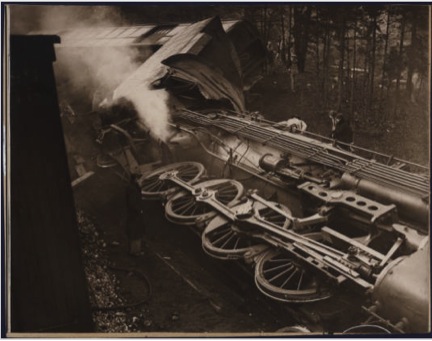
Flamingo Serpentine Wreck, April 23, 1933
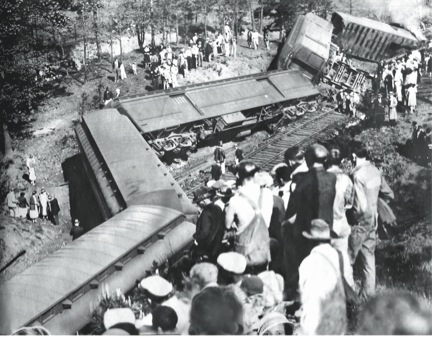
An article appeared in the Tribune News on April 20, 1933 describing a serpentine heap of passenger cars that derailed in the Allatoona Mountains (April 18). Four fatalities (crew and hobos) resulted from the wreck. Also on board this train was the famed, Miss Pittypat (Laura Hope Crews) of the legendary Gone with the Wind novel. George Evans, engineer and Denny Giles, fireman were both scalded to death in the cab. A. H. Perry, a hobo was found crushed to death between the tender and mail car. The engineer and fireman were removed through the cab window of the over turned Flamingo locomotive. Three other injured hobos were found between the engine and baggage car. Clifford Decker also penned between the tender and baggage car was taken to Crawford Long hospital in critical condition, but died later. The wreck stretched over 500 feet in a scrambled heap. A Negro hobo was seen running from the scene exclaiming he did not want to be charged for stealing a ride. The conductor, L. C. Butcher was in charge of the Flamingo and reported all passengers were safe.
Flamingo Gold Robbery Wreck, April 18, 1933
A subsequent story was report by the Atlanta Constitution indicating the Flamingo may have been intentionally wrecked. The Flamingo was a fast passenger train operated by the L&N RR that ran between Cincinnati, Ohio and Jacksonville, Florida. It was well known to often transport gold to points across the south. On April 17, 1933 the train derailed in Emerson, Georgia resulting in two lives being lost in the accident. Witnesses reported seeing three white men attempting to break into the express car that was directly behind the engine and tender car. The suspected robbers escaped, but detailed descriptions were given to the railroad police and local sheriff, George Gaddis. A week after the fatal accident the local Grand Theater featured live film footage of the wreck.
L&N Washout, 1938
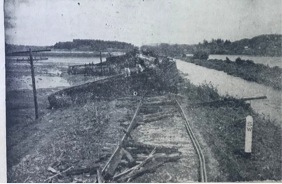
On April 14 area creeks in northeast Bartow County quickly swelled and covered large sections of track between Bartow and Gordon Counties. A raging torrent of rain washed a section of L&N track away south of Fairmount causing 18 freight cars to pile up. Sulfuric acid spilled delaying repairs. No fatalities were reported.
Two Killed in Gruesome Train Wreck, July 20, 1940
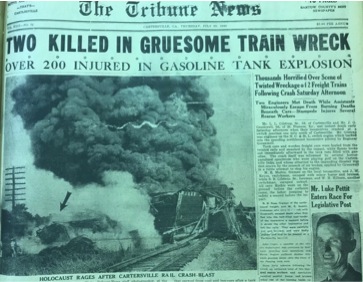
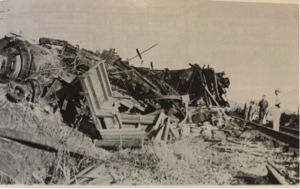
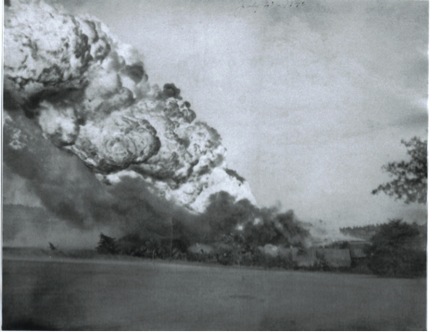
What appears to be the most horrific train wreck in Cartersville occurred July 20, 1940 when a switch mishap caused an inferno collision. Mixed track signals were blamed for a fiery collision between two locomotives and fourteen derailed freight cars just south of Cartersville next to the old Cartersville golf course (Tinsley Park) on highway 293. A NC&St.L locomotive was pulling off a side spur onto the main track in route to Thompson and Weinman. A northbound freight traveling at a high rate of speed collided with the switching southbound NC& St. L resulting in a massive smash-up and fire ignited from a fuel tanker. Scores of spectators gathered to see the carnage following the collision and were deathly panicked when a gasoline tanker car exploded unexpectedly. The blast was so catastrophic that it stampeded the crowd causing trampling. Families were separated, children lost in the chaos and desperate screams were heard to find loved ones. Fleeing observers received burns, cuts and bruises from trying to escape the raging fire. Some were trapped between the fire and wire fence causing desperate attempts to climb over the fence works. Flames shot several hundred feet high, people jumped to shelter, some dropped to pray and others ran. The heat was so intense that firefighters and rescue personnel had to have water hosed over them to continue rescue efforts. Over 200 people received injuries from the sudden explosion and fear stricken reaction to run from the blast. The local Stanford hospital was over run with injured people.
The engineers of both trains perished in the wreck with Mr. Greenwell of the northbound locomotive found crushed under a freight car and Mr. Gilstrap piloting the southbound train was found at the cab throttle with a broken neck and crushed shoulders. A third train arrived and the engineer, Mr. Ross entered the fire to rescue his colleagues. He summoned help from stand by golfers who were on the near by course. It took several days to clear the wreckage and attracted 20,000 spectators from miles around to see the carnage.

L&N Spills Tons of Coal, 1960’s
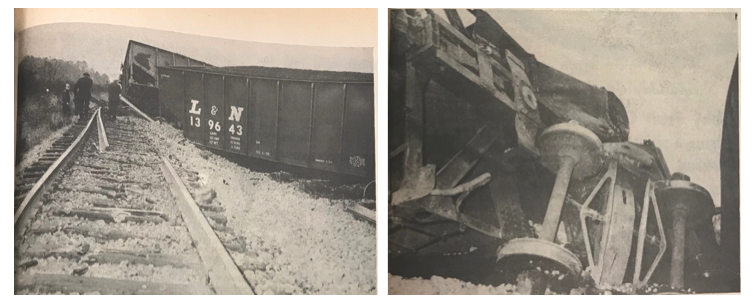
The Tribune only offers a brief mention of a L&N coal train over turning north of Cartersville. No cause, specific location or injuries were reported.
Train Derails in Cartersville, 1960
Seventeen cars were derailed a few blocks south of the central Cartersville business district in mid December. A southbound NC&StL freight lost several cars when they jumped the tracks with one car running into a lumber shed at the J. Hugh Gilreath Lumber Co.
Junta Yard Pile Up, 1953
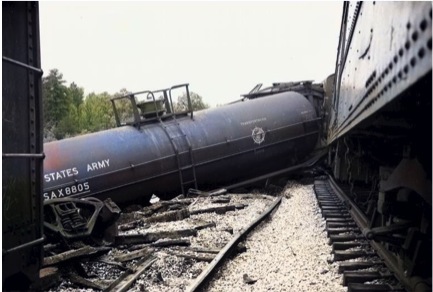
Courtesy of Tribune News and Bartow History Museum
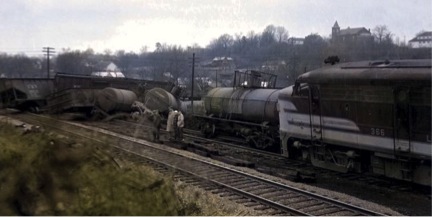

While not definitive it appears a derailment occurred north of Cartersville in the vicinity of the Junta signal tower switchyard just north of the former E Z Knitting Mills. According to photos from the newspaper this wreck occurred in January 1953, but no story was located to support this pile up.

Courtesy of Tribune News and Bartow History Museum
According to the May 21, 1953 Tribune a freight train piled into a Dixie Flyer passenger train on Hall Station Road. The passenger train stopped to allow the freight to pull on to a siding. As the southbound freight pulled onto the siding its cars began to jack knife into the passenger train resulting in the derailment of 11 cars between the two trains causing four cars to overturn and two of which contained liquid chlorine. Chemical specialists were rushed in to supervise how to evacuate the hazardous liquids.

Photo courtesy of the Tribune News
In mid December of 1958, a northbound L&N freight train wrecked on the north end of Kingston completely destroying the center section of the overhead bridge at Hall’s Station Road. According to an account by Sara Johnson as published in the book Remember Kingston, by Martha Mulinix, train cars were in her grandfather’s (C. E. Pratt) and neighbors gardens. Freight such as towels, sheets, blankets and appliances were scattered all along the tracks. People did not go to work or attend school that day in order to see the recovery and salvage goods from the wreck. Seven box cars scattered into neighboring yards. The cause of the crash was considered to be a “hot box” failure. (A set of wheels and axles that became over heated and disintegrate from extreme stress causing the trollies to breakup from lack of grease and lubrication.) The clean up and bridge reconstruction took months to restore.
17 L&N Cars Derail, 1960
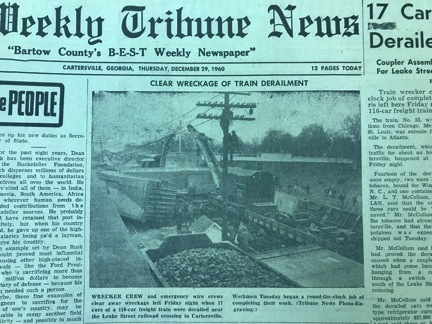
A freight train number 55 pulling 116 cars through Cartersville at about 7:30PM lost 17 cars on the W&A at the Leake Street crossing. All but two of the cars were empty with the remaining two hauling tobacco and potatoes. Officials determined the derailment was caused by a coupler – assembly that disconnected. The damaged cars were refrigeration units costing approximately $27,000 each. Emergency power line crews had to be brought in to restore electrical service and clear dangerous live wire. No injuries or fatalities were suffered.
Derailment Sends Acid into Creek, 1962
An L&N train from Etowah, Tennessee to Atlanta developed a “hot box” wheel and derailed just north of the city. Four tank cars ran down an embankment and spilled sulfuric acid into Pettit’s Creek. The accident caused no injuries. Residents were warned to stay clear of the area keeping children and pets away until the chemical become diluted and harmless.
L&N Cars Derail in Adairsville, 1962
Fourteen cars of a 106 car train derailed north of Adairsville. The cars were badly damaged, but no injuries were reported.
Adairsville Rail Wreck Leaks Acid, 1963
A rail car transporting sulphuric acid was among nine cars that derailed in the downtown Adairsville business quarter and narrowly missing houses. A city square block was roped off and near by residents were evacuated. Bartow County Rescue officers plugged the punctured tank with a rubber inner tube using a long pole.
Twenty Freight Cars Leave Track, 1964
Mixed coverage from several newspapers reported that between 20 and 24 L&N cars derailed north of Acworth near Emerson in Bartow County. The Marietta Daily Journal declared three wrecks had occurred in the same vicinity during the same summer.
L&N Freight Derails in Kingston, Tragic death, 1964
Twenty four cars of a NC&StL derailed near Kingston resulting in approximately 500 feet of damaged track. While there were no injuries at the site, a death was reported several days following the incident. A 16 year old boy was found during the clean up having been smothered in bushels of corn and debris that was being loaded in a hopper.
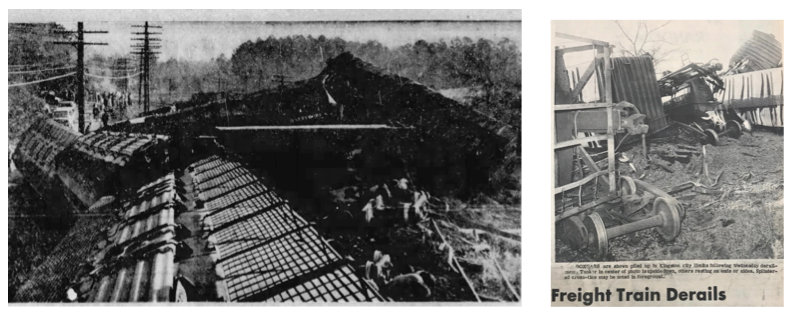
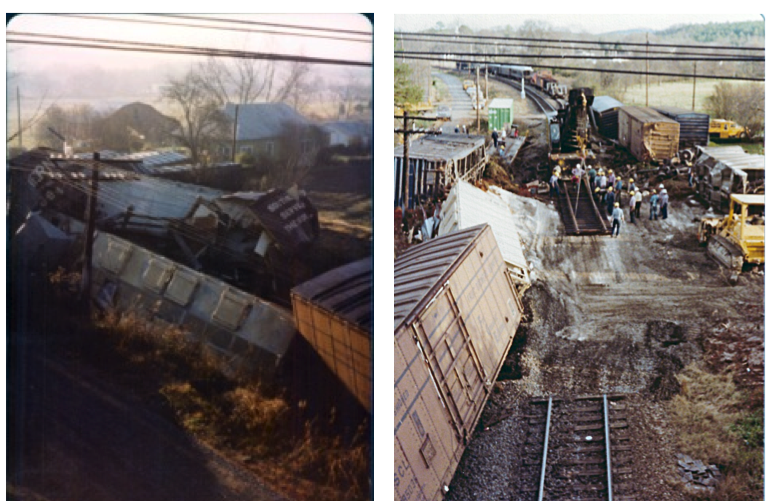
Train Derails North of Town, 1970

On December 17, a southbound L&N freight train derailed north of the city at 6:15 AM. The accident occurred one quarter mile north of the Jones Mill Road underpass.
A witness reported seeing a “red hot wheel” on one of the freight cars as he waited to cross the tracks. Six cars derailed and massed into a tangled pile while another car loaded with coal did an undetermined amount of damage. There were no injuries or fatalities reported in this incident.
Train Derails Smashes Emerson House, 1974
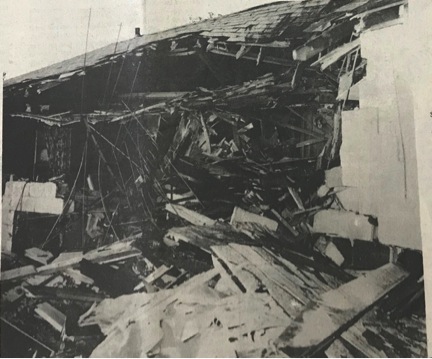
Three people were injured and taken to the hospital September 26 when a L&N train derailed in Emerson. A northbound freight pulling 17 cars derailed about one block north of the Morris Grocery Store (Doug’s Place) and struck a house completely demolishing the structure and injuring 3 people. Occupants of the house were Mrs. Tom Kincannon and her two children, Kevin and Melissa. The cause of the wreck was not reported.
Derailment in Adairsville, 1975
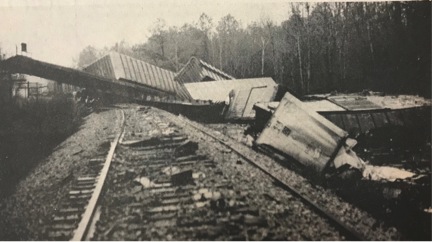
A northbound L&N freight train derailed at Bowdin’s Crossing north of Adairsville on January 9, 1975. Twenty-two cars piled up as a result of a broken rail according to a spokesman from the railroad. The train was L&N’s number 620 headed for Chicago. Rails and cross ties were significantly damaged. There was one fatality and no other injuries reported. Wreckage was cleared in about 24 hours.
Plant Bowen Coal Derails at Dairy, 1975
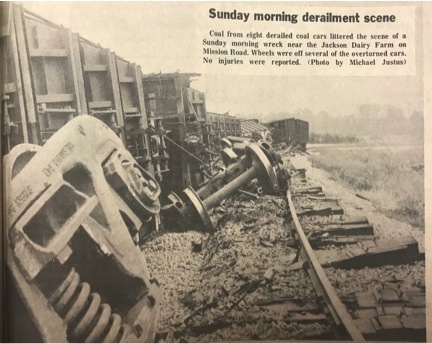
According to an L&N spokesman eight coal cars destined for Georgia Power’s Plant Bowen derailed with some overturning on December 4, 1975 across from the Jackson’s Dairy farm on Mission Road. Train wreckers were brought in the following week to remove the wreckage. No injuries were reported.
Railroad Cars Derail North of Kingston, 1975
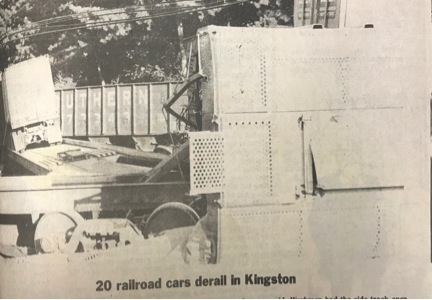
The Tribune News reported September 2 that approximately 20 L&N railroad cars derailed north of Kingston. It took three days to fully clear up the wreckage. No one was injured in the accident.
Six Coal Cars Derail on Mission Road, 1975
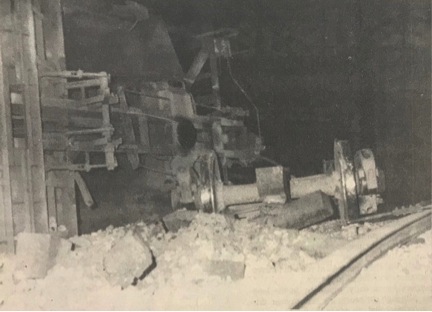
In almost the same location as a previous wreck near Jackson’s Dairy a L&N train derailed spilling six coal cars in route to Plant Bowen. There were no injuries reported.
Three Engines Derail North of Cartersville, 1978
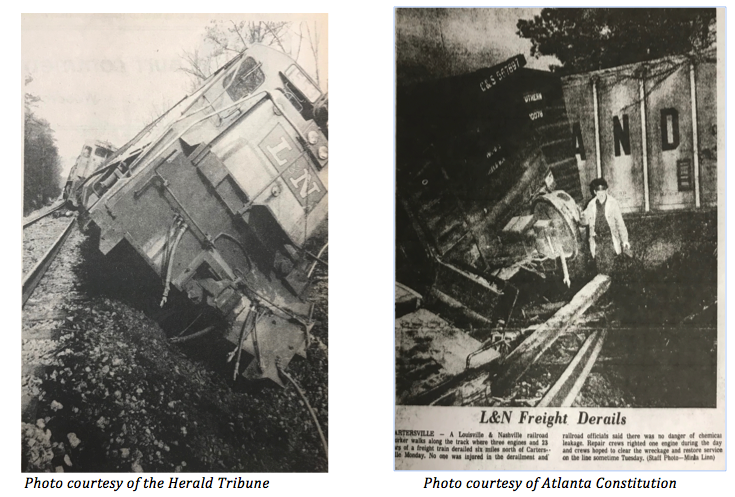
The Herald Tribune reported that three L&N engines and 23 cars derailed at the Cass Station and Iron Belt Road intersection on March 16, 1978. The lead engine did not derail, but the following three engines and cars did derail. No injuries or fatalities were reported. Most of the cars were empty, but some were loaded with goods including aluminum, cable, filters, soybeans and resin. The cause of the wreck is unknown.
Seven Cars Jump the Track, 1979

On November 15, seven L&N cars of a 72 car coal train bound for Plant Bowen jumped the tracks near the intersection of Chulio Road and Mission Road with cars and rails suffering considerable damage. This is near the same site of two previous derailments of coal trains headed to the Georgia Power Plant. No injuries reported.
Kingston, 16 L&N freight cars derail, 1979
Nearly two decades later a northbound freight lost sixteen cars at the same Kingston bridge location at Highway 293 bridge as an earlier wreck occurred in 1958. There were no fatalities, nor injuries, but considerable damage to track and freight cars was sustained. The cars were mostly wooden having splintered and piled on top of each other. According to records this train was known as the shuttle train between Chattanooga and Atlanta.
L&N Train Derails near Stilesboro, 1979
In July of 1979 ten cars were over turned outside of Stilesboro and two others derailed around midnight. The incident was not heard by neighbors and attracted no attention until daylight. The cause for the wreck was undetermined and no fatalities or injuries were reported. The scene was just west of Plant Bowen at Old Taff Road on the old Cartersville Van Wert rail bed.
Off The Line, 1986
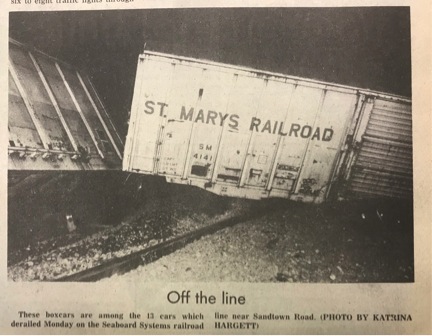
Thirteen Seaboard System boxcars derailed southeast of Emerson near the Sandtown Road. No injuries were reported.
CSX Grain Train Derails, 2010
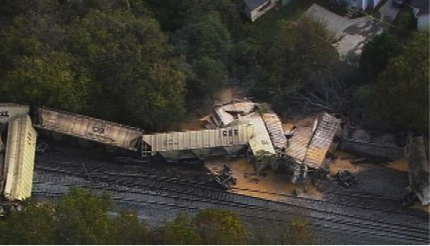
On November 5, 2010 a CSX train derailed north of Cartersville, at the crossing of Felton Road west of Tennessee Street near a residential section. Twenty cars hauling grain jumped the tracks. The train consisted of two locomotives and 74 cars. The train had departed from Michigan headed southbound to Comer, Georgia. There were no fatalities or injuries, but considerable dust and damage to tracks and equipment resulted. CSX staged heavy equipment along Beaver Trail for several days to clear the wreck.
CSX Coal Train Overturns, November 6, 2013
A CSX coal train derailed after delivering its payload to the Georgia Power Plant Bowen in Bartow County west of Cartersville near Euharlee. The train overturned near Beasley Road about 11:15. Two injuries were report and taken to the Floyd Medical Center.
Emerson Crossing Collision, 2020
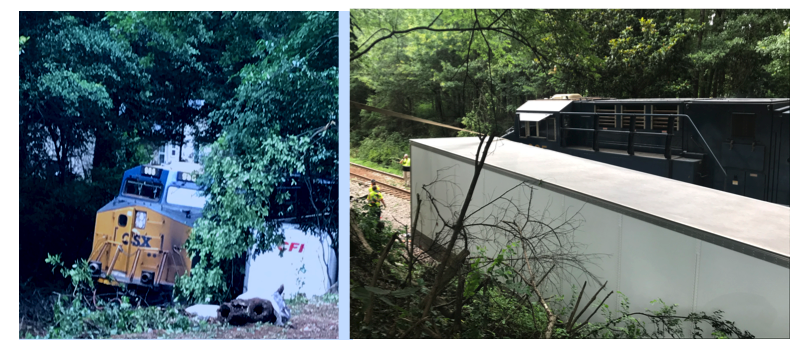
On Wednesday June 24 at 9:15 a tractor and trailer got hung up on the high track crossing on HWY 293 in front of Doug’s Restaurant. The truck driver (Vicky Morris from Missouri) attempted to quickly decouple the trailer from the tractor, but was unsuccessful. She then attempted to accelerate the tractor across the tracks, but was struck by the CSX engine before she could exit the cab. The impact pushed the tractor and trailer north for about a quarter of a mile prior to stopping behind the Southern Girls Produce stand. The truck driver was killed in the impact and the tractor was demolished. It took about five hours to clear the track.
Hall Station Road Derailment, 2020
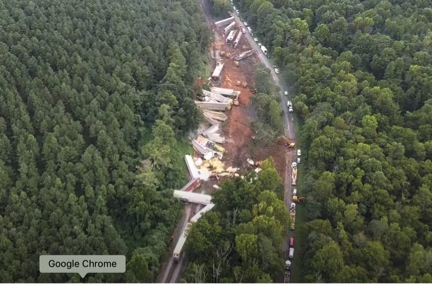
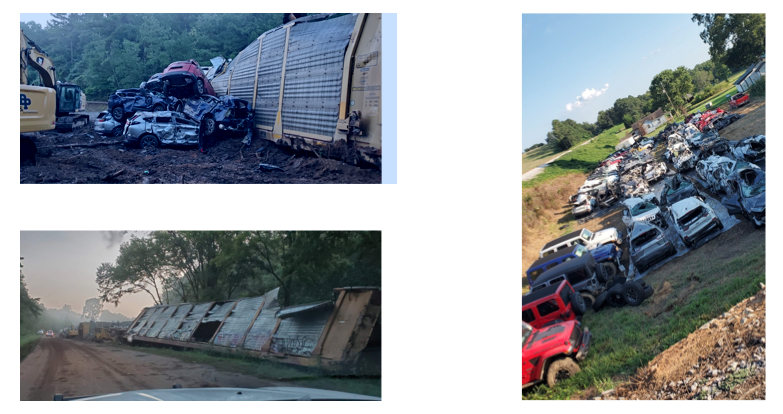
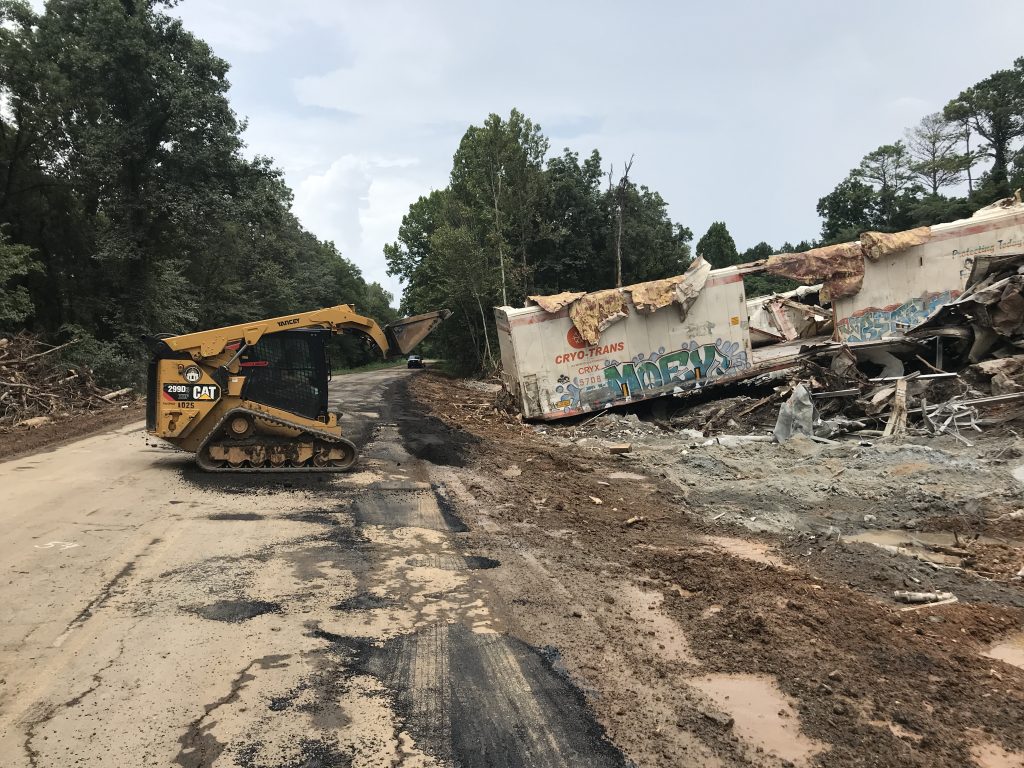
On Friday August 14, ,2020 a CSX train derailed north of Kingston adjacent to the Hall Station Road (Hwy 293) near the Old Hall Station Crossing and Double J Farms. The wreck occurred at 5:00am and involved 35 rail cars that left the tracks. The incident resulted in no injuries and the cause has not been determined. The site was a mass of tangled box cars, hoppers and auto rack carriers. Scores of automobiles being transported were crushed and fully destroyed . Other cargo included cement, rice, potatoes, canned goods and animal tallow. There were no hazardous spills other than minimal diesel fuel posing no threat to water sources. Over 100 men with heavy equipment were called in to remove the wreckage that is expected to take about three days. Damage to Hall Station Road is expected to be significant.
Kingston February 17, 2022
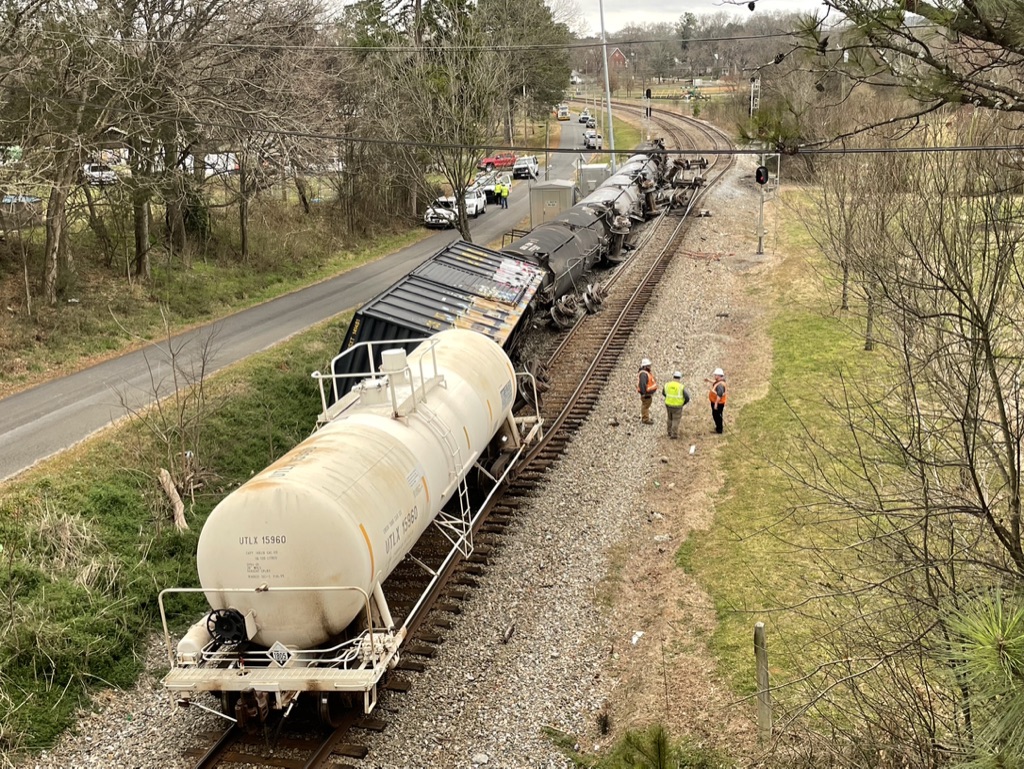
CSX train derails north of Kingston at the Hall Station Road bridge. There were no injuries or discharge of harmful chemicals. Crews worked into the night to clear the tracks. No cause of derailment was determined at the time of recovery.
Token Mention of Vehicle and Train Entanglements
The newspapers frequently reported mishaps, smash-ups, impacts and collisions between locomotives, rail cars or vehicles almost monthly. More horrific were the incidences of literally striking an individual or running over a person leaving them mutilated, dismembered or dead. Listed below are token examples of these tragedies as a tribute to this category of fates.
Convict Killed, 1901
A young white convict was killed at the Sugar Hill mines in northeast Bartow County. Bob Kent was carrying water when a strong wind swept smoke from the engine blocking the view of the engineer and convict. Kent was knocked down and before he could clear the tracks the engine and several cars rolled over his legs severing both. He died soon afterwards.
Train Demolishes Auto, 1938
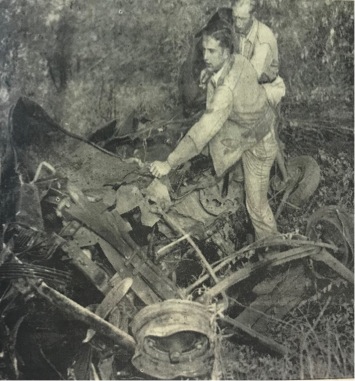
Circa 1938, the famed Flamingo fast passenger train stuck a car attempting to cross over a temporary grade crossing north of Cartersville. Mr. V. C. Autrey and his light coupe vehicle was carried a half mile before the train stopped.
Wreck Victims Awarded Cash, 1940
It was not uncommon for victims of train and auto collisions to receive compensation for rail accidents. Lawsuits and settlements were common between the railroad and injured parties. Such an incident occurred during the Christmas season at the Main Street crossing. On June 20, 1940 the Tribune News reported that the NC&StL agreed to a cash pay out for a mishap involving Mrs. Gertrude Harvey, Mrs. Robert Wilson and a Mr. Pittard each receiving between $1000 and $2000. All three sustained serious leg injuries.
Young Woman Killed by Train, 1962
Shirley Ann Mathison was killed when the car she was riding in was struck by an L&N train at the (former) Cook Street crossing. She was pronounced dead from head injuries at the Sam Howell Memorial Hospital. Louie Head, believed driving the car was injured suffering broken ribs, knees and several teeth knocked out. The automobile was carried 735 feet by the northbound passenger train before coming to a stop. A secondary source cited that this was the fourth young person killed by a train within two years. The previous youth killed in February 1961 was the daughter of the police officer called to investigate the tragedy.
The newspapers hold a cache of reports citing mishaps at street crossings, collisions with cars, trucks, wagons and multiple instances of people being struck by trains while walking on the tracks. Other reports include hobos being found injured or dead along the railroad resulting from various forms of fatalities.
Conclusion
The causes of most wrecks were typically assigned to human error, poor maintenance of the line and faulty equipment. Reports included broken rails, rotten cross ties, neglected switch positions, poor bridge conditions, confused orders, premature turn outs, weather, excessive speed, washouts, coupler disconnects and hot boxes or wheel/axle assembly disintegration.
This research reminds us of the importance of Bartow’s rail history and reveals 180 years of forgotten railroad tragedies. Bartow once thrived with five indigenous railroad beds that eventually develop a storied chapter of train wrecks and rail history. The major findings point to the frequency of wrecks occurred on the W&A RR under the authority of the State and leases including Joseph Brown, NC & St L, L&N and CSX RR’s. As a secondary observation it appears wreck hot spots most often occurred in Kingston, Cartersville, old Bartow mining settlement (Emerson) and the Allatoona community.
As a result of the local rail industry, it became inevitable that train accidents and loss of life would soon claim a piece of Bartow history. As instances occurred no central archive was maintained to preserve a collective memory of wrecks and tragedies. These ghostly train whistles of long ago deserve to have their story not forgotten, but also preserved in a special place of Bartow history.
This work is intended as an initial effort to document “significant” train wreck history occurring in Bartow County from the pre-Civil War period to 2020 by offering a reference for future readers and researchers.
Bibliography
Newspapers, Magazines and Blogs
(Note: Some article titles have been abbreviated for space concerns)
Providential, Baltimore Sun, February 5, 1846
Singular Escape, Brooklyn Evening Star,February 3,1946
Rail Accident, The Georgia Constitutionalist (Augusta) January 30, 1846
Locomotives of the Georgia RR, Merchant’s Review, Vol. 17,1847
A Card, Charleston Courier, January 17, 1852
Derailed Freight Slows Dixie Flyer, Chattanooga Daily, May 20, 1953
Rev. C. W. Howard Letter, Rome Courier, November 20, 1855
Locomotive Explosion, Augusta Chronicle, March 10, 1857
Diabolical Attempt to Blow up the W&A RR, Cassville Standard, April 15, 1858
Railroad Collision, Daily Intelligencer, 9/15/1863
Terrible Railroad Accident, Memphis Daily, 9/16/1863
Serious Accident, Bainbridge Weekly Democrat, February 6, 1873
Accident on the State Road, Atlanta Constitution, 3/5/1873
Card Notice, Atlanta Constitution, September 4, 1874
Run Off, Cartersville Express, February 17, 1876
A Ride to Death, Atlanta Constitution, June 20, 1882
GenDisasters. Com, Cartersville, GA Car Works Explosion, Feb.1882
Explosion at car factory, Weekly Constitution, Feb. 21, 1882 — page 1
Rail Car Manuf & Wagon Manuf., The Atlanta Constitution, April 2, 1882, Page 2
A Narrow Escape, The Cartersville Courant, January 7, 1886
Wreck on the W&A Fireman Killed, Cartersville News, December 20, 1888
Fatal Wreck, Chattanooga Daily Times, December 20, 1888
Smash-Up at Cartersville, Chattanooga Times, August 22, 1895
Jumped For His Life, The Atlanta Constitution, August 22, 1895
Trains Go Together, The Courant American, February 12, 1899
A Bad Collision, Courant American, Circa, March 30, 1890
On the Same Track, Atlanta Constitution, November, 4, 1891
Death on the Rail, Chattanooga Times, June 17, 1893
A Fatal Wreck, Nashville Banner, June 17. 1893
Smash-up at Cartersville, Chattanooga Times, August 22, 1895
A Trestle Falls In, The Courant American, October 20, 1898
Wreck on the Iron Belt, Courant American, 11/8/1900
Double Header Collision, Atlanta Constitution, November 27, 1900
Another Accident, Chattanooga Daily, February 2, 1901
Passenger and Freight Collide, Atlanta Constitution, 2/5/1901
White Convict Killed, Courant American, April 20, 1901
Two Wrecks, Marietta Journal, February 7, 1901
Atlanta Man Hurt in Crash, Atlanta Constitution, July 27, 1906
Nine Men Killed, Saskatoon Daily Star, Canada, November 9, 1912
Thousands Gather at Union Depot, Atlanta Constitution, November 10, 1912
Frightful Wreck Near Bartow, The Cartersville News, November 14, 1912
Wreck Near ATCO, Bartow Tribune, September 3, 1914
W&A Passenger Train Derails, Anderson Intelligencer SC, December 22, 1914
Memphis Limited, Bartow Tribune, December 24, 1914
Two Persons Killed, Fourteen Injured, Charlotte News, NC, December 20. 1914
Two Killed, Twelve Hurt, Atlanta Constitution, December 20, 1914
Wreck Near Cartersville, Atlanta Constitution, January 10, 1914
No Defect Found, Atlanta Constitution, February 25, 1915
Head-On-Wreck Causes Death of 3 Popular Men, The Bartow Tribune, June 24, 1920
Three Men Killed in Rail Collision, Atlanta Constitution, June 19, 1920
Three Killed in Georgia Wreck, Miami Daily News, June 24, 1924
3 Trainman Killed, Tribune News, Jun 19. 1924
Engineer Killed Fireman Hurt, Atlanta Constitution, January 19, 1925
Many Killed and Injured, Blackwell Daily Tribune, February 27, 1923
At Emerson Train Engine Leaves Track, Tribune November 1, 1928
Car Derailed, Two Killed, Atlanta Constitution, April 19, 1930
Engineer, Fireman Die, Engine Five Cars Derail, Atlanta Constitution, April 18, 1933
When Flamingo Wrecked Near Cartersville, Atlanta Constitution, April 19, 1933
Three Gold Robbers Sought in Flamingo Wreck, Atlanta Constitution, May 4, 1933
Creeks Became Raging Torrents, The Tribune News, April 14, 1938
Train Demolishes Auto, Tribune News, Circa 1938
Gruesome Train Wreck, Tribune News, July 25, 1940
Train Wreck Oil Explosion, Tribune News, July, 24, 1941
Junta Yard Photos, Tribune News, January 1953
Freight Piles Into Dixie Flyer, (tabloid?) May 21,1953
Derailed Freight Slows Dixie Flyer, Chattanooga Daily, May 20, 1953
Train Wreck at Kingston, The Weekly Tribune, December 11, 1958
Derailment Sends Acid into Creek, Atlanta Constitution, July 26, 1962
Train-Car Accident Takes Life, Tribune News, November 1, 1962
Twenty Freight Cars Leave Track, Marietta Journal, July 19, 1964
Freight Train Derails at Kingston, The Weekly Tribune News December 9, 1964
Train Derails North of Town, The Weekly Tribune, December 17, 1970
Train Derails Emerson, The Weekly Tribune, September 26, 1974
Adairsville Derailment, Tribune News, January 9, 1975
Sunday Morning Derailment, Tribune, December 3, 1975
Freight Train Derails, Herald Tribune, July 29, 1976
20 Rail Cars Derail North of Kingston, Herald Tribune, September 2, 1976
Train Derails North of Cartersville, Herald Tribune, March 16, 1978
L&N Train Derails near Stilesboro, Tribune, July 26, 1979
Seven Cars Jump Track, Herald Tribune, (Circa November 15?) 1979
16 Freight Cars Derail, Herald Tribune, November 29, 1979
Off the line, Tribune News , April 13, 1986
Train Derails Near Cloverleaf Elementary, Tribune News, November 5, 2010
CSX Hauling Grain Derails in Cartersville, FELA Lawyer News Blog, 2010, http://www.gordon-elias.com/blog/1748/csx-train-hauling-grain-derails-in-cartersville-ga/
Work continues on RR Track after train derailment, Tribune News, November 5, 2010
No injuries or hazardous spills reported in Kingston Train Derailment, Tribune News, August 15, 2020.
Train Derails in Kingston, Tribune News, February 19, 2022.
Articles
Head, Joe F., Cartersville’s Car Manufacturing Age, April 2016, EVHS Bartow Author’s Corner
Head, Joe F, Emerson’s Forgotten Train Wreck, July 2016, EVHS, Bartow Author’s Corner
Martino, Giovanni, Historic Railroads of Bartow County, February 15, 2018, EVHS Bartow Author’s Corner
Head, Joe F, The Heart of the Chase, July 2015, EVHS, Bartow Author’s Corner
Books
Lovell, Caroline Couper, In the Light of Other Days, Mercer University Press, Copyright 1995
Head, Joe F, The Great Locomotive Dispute,1990 & 1997, Bartow History Center
Mulinix, Martha, Johnson, Sara, We Remember Kingston, The Big Train Wreck, 1992
Johnson, James Houstoun, Western and Atlantic Railroad of the State of Georgia, Stein Printing Co, 1925, Copyright 1932.
Acknowledgements
A special thank you is extended to Mr. Sam Graham for his keen research skills in locating train wrecks between 1840 and 1900 in a variety of on-line digital newspapers and government documents. Without his assistance this period of documented train wrecks would have been largely under-represented.
Bartow History Museum Museum Archives
Jeff Williams EVHS Technical Support
David Ibata NC&StL Preservation Society
Todd France CSX Signalman
Elizabeth Nelson Great Granddaughter, 1920 Wreck
Guy Parmenter EVHS contributor
Sam Graham Retired Bartow County Fire Dept.
Michael Vest Graphic Artist
Interviews
Richard Dawson Retired Union Carbide
Sonny Lusk Retired, CSX Railroad
